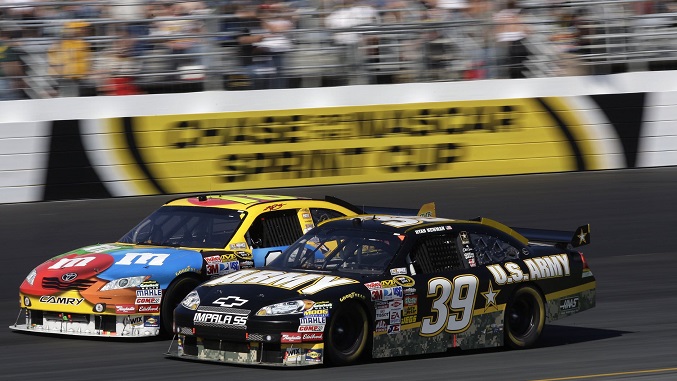How Do NASCAR Teams Figure Out Tire Changes Before And During Races?

Tim Setterfield is an automotive writer who’s looking to expand his brand. He writes on various automotive topics, from products to luxury vehicles. His inspiration stems from working with his dad when he was a kid in his garage.
It is impossible to watch a NASCAR race without noticing the lightning-fast speeds at which the pit crews change tires on the vehicles during their pit stops. The unforgettable zipping sound of the impact wrenches they use to remove the lug nuts is just one of the highly-skilled duties these professionals use to assure a quick tire change.
If racers have ever wondered how these individuals know when to change the tires, the answer is simple. Tires are designed to last as long as a tank of fuel. In other words, when the car stops to refuel, the tires should be ready for a change. However, there is a lot that goes into the process. Let’s take a closer look at the science and art of the NASCAR tire change.
Tire Compound
The science of structuring tires that can both uphold their integrity in this rigorous environment and at performing at the highest level on vehicles driven at excessive speeds. Accomplishing this takes conjuring up compounds that are able to withstand the intensity of a NASCAR race. The composition of the track that the race is held determines the compound used to manufacture the tires.
The composition of the track where the race is held determines the compound used to manufacture the tires. Similar to how Toyo Proxes RRs behave in club racing, you might notice that these tires do better on dry tracks. While Goodyear tires are the tires associated with these races, Toyo has stated that “…this race-ready design eliminates the need for tire shaving and provides ultimate traction with superior cornering force.” The grip is increased with racing tread to improve lap times during races.
NASCAR tires are made from a softer compound than traditional tires. The softer the compound, the more grip they have, but this also means the tires will wear down faster. Some tracks are made of asphalt, and others are made using concrete. The more abrasive the terrain, the quicker the tire wears down. This means that the compound run on tracks made of concrete must be more resilient than asphalt tracks.
Tire Inflation
Contrary to the belief of casual spectators, NASCAR tires are not inflated with oxygen. The internal temperatures of a racecar can reach as much as 200 degrees Fahrenheit. Air is not sustainable at these extreme temperatures, so Nitrogen is chosen; it’s a dry gas, and reduces the pressure fluctuations tires experience during a race.
Measuring Wear
There are indicators built into tire’s design that help determine how badly worn they are. Naturally, NASCAR tires do not have tread. Tread is good for wet pavement – on dry surfaces, smooth tires are better. There are small indentations across the tires that are measured with depth gauges to see how worn the tires are.
Track Surface
There are 31 tracks used by NASCAR. Of these tracks, 28 of them are surfaced using asphalt, the other three tracks are paved with concrete. Some tracks have a combination of both. For instance: the track at Martinsville has corners paved in concrete, with the straightaways formed in asphalt. Over time, the filler that holds the asphalt together eventually deteriorates, which is another reason why softer compounds are used on asphalt tracks.

Track Shape
The shape of the track is another factor that is used to determine the composition of the tires. If a track is oval-shaped, tri-oval shaped, or D-shaped, the tire will have a different composition and different effects on tires. The formula is to structure tires to compensate for the extra wear that the corners impose on rubber. Tracks with severe banking require tires that are more structurally sound.
Lug Nuts
The lug nuts seal the deal when NASCAR tires are changed. You may have wondered how pit crews manage to change tires in 12 to 14 seconds without fumbling around with the five lug nuts that hold on each tire. The answer is simple; they use glue. That’s right; there is an adhesive applied to the lug nuts about three hours before the race. The glue holds the lug nuts in place, so when the wheel is put on the car, the nuts are tightened, and the vehicle is ready to go.

Friction Heat
The friction from the rubber and the track surface produce high temperatures on more than just the tires; this is also dispersed to the brakes and calipers. The area around the brakes can reach temperatures as high as 1200 to 1500 degrees Fahrenheit, which is why these mighty chassis often have a ton of brake ducting.
NASCAR pit crews work with precision and accuracy to assure the structural integrity of the vehicle—including the tires—and the safety of the driver. Working closely with the tire manufacturers is truly where the rubber meets the road. A ton of science goes into just this one aspect of an overall racing engineering marvel, which ought to make anyone appreciate the sport as more than a series of left turns.

















